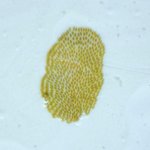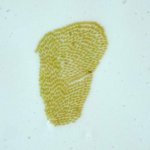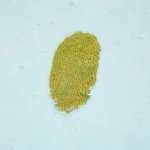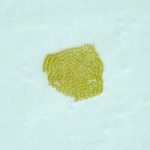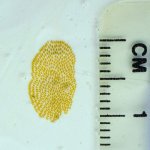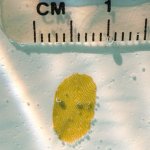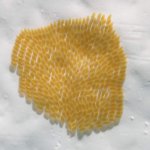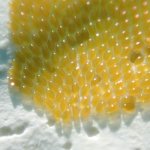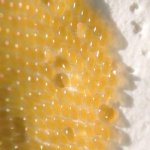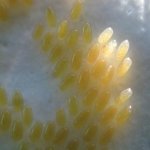My chlorine injection (see signature for details) strategy failed me while on vacation for a couple weeks this summer as I misjudged the frequency I would need someone to refill the reservoir and we sustained particularly high temperatures and wind bringing smoke from all of the California fires. In hindsight my CYA might have been a little low as well. However, the net result was that during the first week of August I came home to a what I consider an objectionable green pool although I've seen far, far worse posted here! Anyway, about a week of a SLAM led to a nice clear OCLT and crystal clear pool again.
Except, less than a week later little dime size yellow spots started to appear nightly in the shady wall of the pool in the top couple of feet especially. So I attempted to SLAM again, but this time the yellow spots returned every night no matter what I seemed to do although I haven't measured any CC since that first SLAM. After reading a pile of posts here about a certain difficult yellow algae I continued to up my game over the following weeks. Upped the FC, pulled the light niche, scrubbed down anything that had been in the pool with bleach, removed and soaked the DE grids in bleach, vacuumed the spots to waste daily, brushed frequently, etc.
As an aside, I witnessed our Dolphin's plastic surfaces hosting the dreaded spots so of course it too received a daily bleach scrub. I should also mention that my method for vacuuming the spots to waste also involves rubbing the wall where the spot was removed with a trichlor puck.
A couple weeks of nightly FC dosage to 17ppm dipping generally dipping to 7ppm in the late afternoon before the dosing pump turned on again. This started at around 40ppm CYA but dropped precipitously to 20ppm over that period I suspect both due to the higher chlorine and the dilutive effect vacuuming the algae to waste every morning. Nevertheless, there was no slowing the yellow spots dreaded appearance every morning despite maintaining a daily regimen of cleaning the light niche, the Dolphin's carcass and filters, brushing many times daily, and a weekly removal and soaking of the DE grids.
This had become tiresome, so on September 10 I decided maybe I'd been lazy about my approach and would leave no stone unturned. I brought my CYA back up to 35ppm, lowered my last known good pH measurement of 7.4 no more than a couple tenths (it's my understanding that measuring pH with high FC is not trustworthy) and brought my FC up to 24 ppm.
The next morning, September 11, I pulled the grids and supporting structure out of the DE filter entirely, scrubbed the interior of the filter with bleach and put it back together without guts as new grids were on the way. I have maintained an absolute minimum of 22ppm FC (0 CC) since then while upping the brushing schedule to about every two waking hours and keeping the Dolphin running as close to full time as practicable. Yesterday, September 12, new grids were installed in the DE filter.
This morning, September 13, the yellow spots made their daily appearance. I have attached close-up underwater photos of the spots for reference. They generally measure 1/2" in diameter (1-2cm). Is this stuff actually the dreaded mustard algae I read of? If you look closely at the photos, it almost appears the little yellow dots build themselves in a counter clockwise fashion. I'd love to try and catch a timelapse of this stuff growing but because I'm brushing the pool all day they are growing between midnight and six in the morning.
Except, less than a week later little dime size yellow spots started to appear nightly in the shady wall of the pool in the top couple of feet especially. So I attempted to SLAM again, but this time the yellow spots returned every night no matter what I seemed to do although I haven't measured any CC since that first SLAM. After reading a pile of posts here about a certain difficult yellow algae I continued to up my game over the following weeks. Upped the FC, pulled the light niche, scrubbed down anything that had been in the pool with bleach, removed and soaked the DE grids in bleach, vacuumed the spots to waste daily, brushed frequently, etc.
As an aside, I witnessed our Dolphin's plastic surfaces hosting the dreaded spots so of course it too received a daily bleach scrub. I should also mention that my method for vacuuming the spots to waste also involves rubbing the wall where the spot was removed with a trichlor puck.
A couple weeks of nightly FC dosage to 17ppm dipping generally dipping to 7ppm in the late afternoon before the dosing pump turned on again. This started at around 40ppm CYA but dropped precipitously to 20ppm over that period I suspect both due to the higher chlorine and the dilutive effect vacuuming the algae to waste every morning. Nevertheless, there was no slowing the yellow spots dreaded appearance every morning despite maintaining a daily regimen of cleaning the light niche, the Dolphin's carcass and filters, brushing many times daily, and a weekly removal and soaking of the DE grids.
This had become tiresome, so on September 10 I decided maybe I'd been lazy about my approach and would leave no stone unturned. I brought my CYA back up to 35ppm, lowered my last known good pH measurement of 7.4 no more than a couple tenths (it's my understanding that measuring pH with high FC is not trustworthy) and brought my FC up to 24 ppm.
The next morning, September 11, I pulled the grids and supporting structure out of the DE filter entirely, scrubbed the interior of the filter with bleach and put it back together without guts as new grids were on the way. I have maintained an absolute minimum of 22ppm FC (0 CC) since then while upping the brushing schedule to about every two waking hours and keeping the Dolphin running as close to full time as practicable. Yesterday, September 12, new grids were installed in the DE filter.
This morning, September 13, the yellow spots made their daily appearance. I have attached close-up underwater photos of the spots for reference. They generally measure 1/2" in diameter (1-2cm). Is this stuff actually the dreaded mustard algae I read of? If you look closely at the photos, it almost appears the little yellow dots build themselves in a counter clockwise fashion. I'd love to try and catch a timelapse of this stuff growing but because I'm brushing the pool all day they are growing between midnight and six in the morning.


